The City of Champaign will be considering an Accessory Dwelling Unit (ADU) ordinance at their June 21st meeting. This is exciting for several reasons, but first, what is an Accessory Dwelling Unit?
An ADU is a small living space in, near, or around but separate from the main house on a lot. The idea behind ADUs is not new. In fact, they were only recently made illegal, so there might be an ADU or two in your neighborhood already. You might even live in or know someone who lives in an ADU — they are commonly basement or garage apartments. ADUs are small units with a kitchen, bathroom, and bedroom. They are like a tiny home, but not on wheels, ADUs are permanent fixtures on the lot.
The ADU ordinance being proposed outlines the rules about what can or cannot be built, you can find it here. The ordinance updates the code to allow homeowners to add a unit to their property if they so choose. Homeowners would have the freedom to build on their own property and our community would get additional housing.
Much of our community is zoned for only single family homes, which means that only one house is allowed per lot making duplexes and apartments illegal to build on lots with that specific zoning. Allowing ADUs would mean doubling the amount of housing on the lots that choose to build which would have a huge impact in our community. Since those units are smaller, they would be much more affordable than buying an entire house.
ADUs are a great option for anyone, but they offer distinct benefits for seniors which you might have picked up from their other name, “granny flats”. An older relative or neighborhood senior could live independently in an ADU, but nearby to family or support in case of emergencies. ADUs are also a great option for seniors looking to downsize or avoid dealing with stairs. These units would be affordable for someone on a fixed income and they tend to be one floor. Even AARP has come out in support of ADUs, publishing educational materials on what they are and how to build them. ADUs would mean that a senior could age in place and among their community, which we know adds to quality of life and fights off loneliness.

Image from AARP’s The ABCs of ADUs brochure.
Another population that would greatly benefit from this additional housing option is young adults. With the housing market in such rough shape right now, ADUs would provide the privacy and affordability essential for young adults who want to get out of their parents’ house, but are also trying to save money. Someone starting out or with a lower income could choose to live in a neighborhood they might not otherwise be able to afford by living in an ADU. They could enjoy the benefits of neighborhoods that are near parks, restaurants, and on bus lines.
Renting out an ADU would also mean an additional income stream for homeowners and added value. Rising costs of living and stagnant wages are creating stress for everyone, and an ADU would represent an investment uniquely suited for our transitory town. When not rented out, an ADU serves as a guest house for visitors.
For all the benefits of ADUs, it must be noted that the underlying problem is lack of affordable housing options and ADUs do not fix that problem alone. Only allowing people who can buy houses into certain neighborhoods is exclusionary and discriminatory. As a community, we cannot decry the explicit racism of past housing practices like redlining and yet perpetuate the policies set up to enforce those past practices. This is even gaining traction at a federal level. Last year, the Biden administration included zoning reform as a part of the American Jobs Plan. We must build duplexes and cottage courts, more housing that allows more people to live near the centers of town.
Passing this ADU ordinance will not solve racism or absolve our community of its past sins of redlining and discriminatory practices around home buying and lending, but it is one small step toward building housing that people can afford. In a growing area like ours, it is important to plan for a future where there is enough housing near the places people want to go and where our public transportation connects all our neighborhoods. Reducing our sprawl by building higher density housing would encourage efficient use and maintenance of our resources and it would reduce our reliance on cars leaving more room for people — people that make this community great.
I love that in this town, I don’t have to use my car very often because I have the privilege of living close to my job and the places I want to go like West Side Park, Cafe Kopi and Quality. I love being able to run into people I know while walking around and I want other neighborhoods to feel that way. ADUs are a step in that direction and if you are interested in a community that deliberately plans and builds for its citizens regardless of race or class, I encourage you to let your city council members know.
If you live in Champaign, you can submit feedback here encouraging them to support the ADU ordinance at Tuesday’s meeting. If you live in Urbana, you can find your council member here and let them know you are interested in ADUs.
If you are interested in more housing options, more transit options, and reducing our reliance on cars, I encourage you to join the CUrbanism Club.
Adani Sanchez has been a resident of Champaign for nearly nine years. She works for Champaign County Health Care Consumers and is Co-lead of CUrbanism Club. She has a cat and enjoys walking downtown with her partner.








